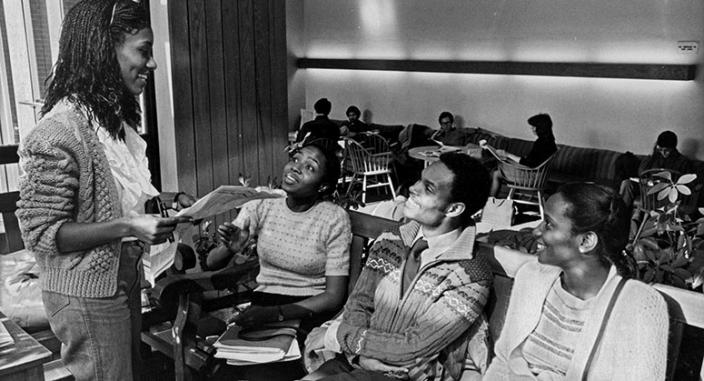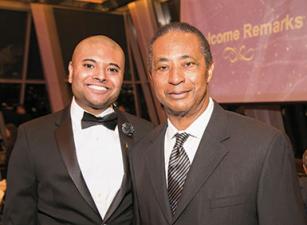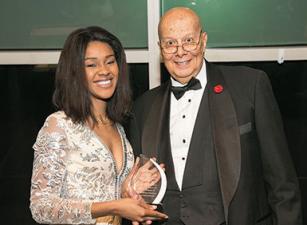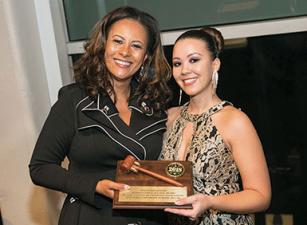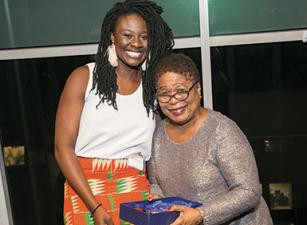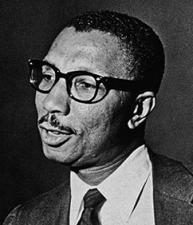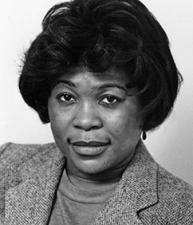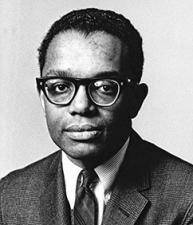For 50 years, the Black Allied Law Students Association has been a voice and a community for students at NYU Law.
BY MICHELLE TSAI
When the Class of 1969 came to NYU Law as 1Ls in the fall of 1966, the United States was in the midst of cultural and political upheaval, and Washington Square Park was an epicenter of change. The Voting Rights Act of 1965 had become law only the previous year, and the civil rights movement was sweeping the country. Artists such as Jimi Hendrix, Bob Dylan, Allen Ginsberg, and Kool and the Gang performed in neighborhood cafés like Cafe Wha? and Le Figaro; beatniks and hippies thronged the park; and at NYU students protested the Vietnam War and demanded broad curriculum changes.
The black students in the Class of 1969 faced significant pressures in the mostly white community of the Law School. They often struggled internally with competing priorities of individual achievement and improving conditions for the black community. “Black students cannot expect to pick up their diplomas and books, wrap their cloaks about them, and go away and live as if the ‘brothers and sisters’ didn’t exist,” wrote Joseph Armstrong ’69, a graduate of Howard University who penned a series of columns examining the black law student experience in the student newspaper The Commentator. In classes, Armstrong wrote, black students were caught in a “crossfire” when issues involving race came up, while outside of class they felt besieged by white classmates who wanted to discuss race issues. “The ‘all eyes on you’ idea is real, not imagined,” Armstrong wrote.
Armstrong and some of the other eight black students in the Class of 1969 had arrived a few weeks early on campus for a legal writing class designed to offer extra support. The legal profession was beginning to open for more black students, and NYU Law was ahead of the times in efforts to diversify. (According to a 1968 report from a committee of the Law School, data from the Association of American Law Schools showed that of the 14,665 law students who graduated from 126 association law schools in 1965, fewer than 100 were black.) A small number of white students felt that the summer program gave participants an unfair advantage, although the issue soon disappeared, recalls Robert Holmes ’69.
Algernon “Jay” Cooper Jr. ’69, who was Armstrong’s roommate in the summer program, says that Dean Robert McKay wanted NYU Law’s black students to be rigorously prepared “so no matter what we decided to do—civil rights, criminal law, or work at a law firm on Wall Street—we would be as well trained, as assertive, as aggressive as anyone else who ever graduated NYU.”
In April 1968, the assassination of Martin Luther King Jr. came as an explosive shock to the nation and the Law School community. Riots swept the country. Within all these crosscurrents, the Black Allied Law Students Association (BALSA) came into being.
Cooper recalls that the idea for a black law students’ association had first come up in discussions with his roommates in the summer program. “We would just bump this idea around like law students can,” says Cooper, until finally they drafted a constitution with bylaws. Berle Schiller ’68, then president of the Student Bar Association (SBA), the student government, remembers that the SBA provided seed funding to BALSA, initially called the Black American Law Students Association. Members of the group acted as legal observers at demonstrations protesting alleged discrimination against blacks and Jews at the New York Athletic Club, Cooper recalls.
Holmes points to King’s assassination as a galvanizing spark for the organization: “It was almost like somebody said, ‘Brothers and sisters, what are you going to do now?’” He remembers giving a speech at a heated gathering at the student union. Afterward, he says, while walking with Cooper, he encountered Roscoe C. Brown Jr., an NYU professor who had been a Tuskegee Airman in World War II. “He could see in our faces that we were really angry, and we were going to do something,” says Holmes. “He said, ‘Fellas, I can’t tell you what to do. But just try to do something that will last.’”
That is just what Cooper, Holmes, and the other first members of BALSA did. Although their numbers were small at the outset, the advocacy and leadership of BALSA members helped position NYU Law as a law school at the vanguard of equality and social justice.
Six days after King’s assassination, the NYU Law community gathered for a “day of examination,” according to the April 17, 1968, issue of The Commentator. According to the article, Dean McKay spoke about the challenges of recruiting black students and efforts to increase financial aid for black students. He also pointed to Law School programs such as the Welfare Law Project, Legal Aid, and the Hays Civil Liberties Program, and noted that many courses at the Law School were relevant to the problems of discrimination and poverty.
Over the next few weeks, BALSA collaborated with the SBA, the Law Students Civil Rights Research Council, and other student groups to advance proposals to increase the number of black students, faculty, and staff, and create opportuni.ties for community and public service work. In May, the Faculty-Student Committee on Racial Problems at the Law School, led by Professor Graham Hughes, published a report endorsing many of BALSA’s proposals. The Hughes report called for the Law School to take action alongside NYU and schools like Harvard University and Yale University to recruit more minority faculty, and to aim for a real “jump” in numbers of minority students while providing academic and financial support to ensure student success. “The times call for radical innovations,” the committee members wrote.
The Law School adopted these recommendations, plus others: appointing a black administrator in the admissions office to recruit and advise minority students; increasing scholarship funds; creating a clinical program in welfare and poverty law; and forming a clearinghouse to connect students with municipal and community organizations.
By this time Cooper was determined to take BALSA national. He traveled uptown to Columbia Law School to start a second chapter, and then headed south to Howard University School of Law to found a third chapter, driving the Austin-Healey 3000 Mark III that his father had given him upon college graduation. With $5,000 in support from the Ford Foundation, Cooper ultimately seeded 26 BALSA chapters, traveling around the country as national treasurer of the American Bar Association’s Law Student Division.
Today, BALSA at NYU Law is one of 200 National Black Law Students Association (NBLSA) chapters at law schools around the country. NBLSA holds job fairs, sponsors moot courts, hosts aca.demic retreats and networking events, participates in policy discussions with lawmakers, and counts more than 15,000 alumni throughout the legal profession.
In short, what started out as a kernel of an idea during Cooper’s 1L year at NYU Law has expanded into an institution that has shaped genera.tions of American lawyers.
A Community Within a Community
As more black students enrolled at NYU Law, the BALSA community grew. Just as BALSA members in the class of 1969 had supported each other, so black students have leaned on each other in all the years since. Some have been first-generation law students, or even first-generation college students.
“Many of us didn’t have the done-it understanding that would have come from parents about how to get through law school, how to think about law firm internships and clerkships,” says Dean Garfield ’94, who is now president and CEO of the Information Technology Industry Council, an advocacy and policy organization. “So the support system was each other. My closest friends in life are the people I met in law school at NYU.”
In 1978, BALSA members took a lead role in founding the alumni organization now known as Law Alumni of Color Association (LACA). Garfield notes that when he moved to Washington, DC, from California in 2009, he found a BALSA network in place that included Congressman Hakeem Jeffries ’97; Anthony Foxx ’96, former secretary of transportation under President Barack Obama; and Keith Harper ’94, Garfield’s law school roommate, who would become ambassador to the United Nations Human Rights Council.
BALSA has also served as a home away from home, a place where students could connect on issues relevant to the black community. The O.J. Simpson trial and the Rodney King beating occurred while Garfield was in law school. “I remember riots and storefronts broken in New York during that time,” says Garfield. “BALSA was a place that we could engage constructively and talk about the issues that were pertinent to society at the time at NYU.”
He recalls a table on the first floor of the library where BALSA friends always sat—a place so full of warmth and a sense of family that it felt like a Thanksgiving table to him. “You could not enter the library without stopping at that table,” Garfield says.
For Gani Afolabi ’19, BALSA helped her grapple with emotional stress from reported police shootings of African Americans. “In those moments of extreme hurt, it was BALSA that was there,” says Afolabi, who was BALSA’s chair in 2017–18. “To be in a room of people who felt the same way you do is important.”
With about 100 members, the BALSA chapter at NYU Law today functions as both professional organization and social group. Each 1L is matched with two mentors in the upper years. Members share advice on subjects ranging from classes and the job search to the best black hair salons. “I had many BALSA mentors who shared many outlines with me, and that was important to my success as a student,” says Afolabi. The year begins with a weekend retreat in upstate New York, where students bond while go-carting, paintballing, or playing golf. BALSA also holds a day-long resumé boot camp in the fall, which is fortified by interview workshops and panels with alumni from different law firms.
Part of what makes the BALSA network so powerful are the lengths to which alumni will go to support one another and current students. “Whenever I reached out to an alum from any year and said, ‘Hey, we need X,’ they were there,” Afolabi says.
Three years ago, BALSA began sponsoring a service trip to West Africa over winter break. Last year, about 20 students volunteered in Ghana with the Happy Kids Foundation, holding workshops for teenagers in an orphanage about career development, job interviews, and sex education. Students also visited historical sites such as Ghana’s “slave castles,” forts where slaves were sold. “Particularly for our students who are African American and whose families have been [in the US] for generations, it was very emotional,” says Afolabi, whose family is from Nigeria.
Students from BALSA—as well as other affinity groups—also play a key role in bringing more students of color to NYU Law by reaching out to admitted students. “Their efforts have gone a long way to helping us attract and enroll the types of candidates who will not only be successful at the Law School, but who will also be involved community members long term,” says Sandy Williams, assistant dean for JD admissions.
Visiting NYU Law as an admitted student, Chigozie Onyema ’11 wondered whether he really belonged at the school—until a student invited him to a BALSA event. Meeting BALSA members transformed his experience, Onyema says: “I was certain, once I left that day, that I was coming to NYU Law.”
Unfinished Business
Not unlike their predecessors, the black law students of today pursue their legal education as issues of race and criminal and social justice are at the forefront of the national conversation. And while changes have been made, many of the same challenges persist in law school and the legal profession.
Black law students across top schools continue to express concerns about representation in the student body and faculty, as well as in the contextualizing of case law in their courses. And there is still work to be done once they enter the working world: Despite an increasing focus on diversity among law firms, African Americans made up only 3.14 percent of lawyers at US firms in 2017, according to the 2017 diversity survey from Vault/Minority Corporate Counsel Association.
NYU Law has committed itself to being part of the solution by making diversity and inclusion a pillar of its strategic plan, focusing, among other things, on expanding recruitment efforts for faculty and students of color, bolstering the pipeline to the legal profession with programs to prepare undergraduate and precollege students for law school, improving the climate in and outside the classroom, and providing new platforms for scholarship and action. Among other steps, the Law School created the Center on Race, Inequality, and the Law (CRIL) and the Center for Diversity, Inclusion, and Belonging to serve as spaces for thought leadership on these issues, to improve the Law School climate, to identify ways for the curriculum to engage issues of race and social context, and to influence the broader legal profession. “[The] use of the law to push the society to confront its obligations is really key,” said Professor of Clinical Law Bryan Stevenson at CRIL’s launch, in a panel discussion of the role of lawyers in addressing inequalities in the US.
Though the Law School has made significant progress, there is broad agreement that more remains to be done. Last spring, students at Stanford Law School, Harvard Law School, UC Berkeley School of Law, NYU Law, and other law schools took actions to raise awareness of discrimination on campus. Some members of BALSA and other groups helped organize events at NYU Law. “This week is about making our schools reflective of and accountable to people of color by incorporating our perspectives, experiences, and voices into our studies and practice,” the organizers of the campaign, #RacismLivesHereToo, said in a statement. “Together, we hope that we can begin the process of reimagining a more equitable and transformative idea of legal education and practice.”
“A pledge to continued progress in making this a more diverse and inclusive school is an important part of how I see the Law School, both as an institution of learning and as a place where people find—and feel part of—a community,” said Dean Trevor Morrison in an email to the student body.
Students from BALSA and other groups are key partners in moving the institution forward. “I appreciate that student voices can and should inform our continued work toward achieving the goals we set for this institution, and I share the urgency that many students feel on these issues,” said Morrison.
A Golden Anniversary
Last February, in celebration of its first five decades, the BALSA community gathered at a Rosenthal Pavilion gala. Announcing that the Law School would install a plaque near Golding Lounge to commemorate BALSA’s founding, Morrison thanked the organization’s founding members for “their amazing vision.”
Cooper and Holmes were both in attendance. Each had taken on significant roles after law school. The first African American mayor of Prichard, Alabama, Cooper was also chief of staff and tax counsel to Congressman Harold Ford Sr. Holmes had a long career in entertainment law and business, negotiating record deals with artists such as Diana Ross and leading Columbia Pictures Entertainment Music Group as executive vice president.
The event also honored Lisa Marie Boykin ’95, who is now senior counsel, business and legal affairs, at Netflix; Professor Paulette Caldwell; and Chigozie Onyema, now policy and regulatory affairs director at the New Jersey Department of Community Affairs. Holmes and event co-chairs Micah Desaire ’19 and Ellen Gong ’18 awarded three high school seniors $3,500 BALSA Legends scholarships, funded with Holmes’s support.
In his keynote remarks, Cooper said that he had created BALSA as a “bridge over troubled waters” where black students could support each other. He noted that much work remained. “Right now, the most segregated time in America, aside from church on Sunday, is at partnership meetings in major law firms,” Cooper said, referencing Martin Luther King Jr.’s comment about segregated worship in the US.
Onyema addressed the continuing civil rights movement. “As we engage in the important work of the Third Reconstruction, we must use every tool at our disposal,” he said, using a phrase popularized by civil rights leader William Barber II. “Let’s discover our mission and never betray it. Victory is ours if we fight for it.”
His remarks were met with a standing ovation.
Michelle Tsai is public affairs officer at NYU Law. Additional reporting by M.P. McQueen.
BALSA demonstration, 2015: Ajani B. H. Photography; BALSA members, 1984: Gallo
Posted September 4, 2018
Sidebar: Role Models
The members of the newly formed BALSA at NYU Law didn’t have to look far for inspiration. Starting in the 1960s the Law School began to attract prominent veterans of the legal fight for civil rights. These included Robert Carter, who argued the landmark case Brown v. Board of Education before the US Supreme Court and served as chief deputy to Thurgood Marshall at the NAACP Legal Defense and Educational Fund, and Leroy Clark, another former NAACP LDF attorney, who joined the Law School in 1968 and became its first black tenured faculty member in 1974. Carter taught at NYU Law until 1971, as a lecturer and then as an adjunct professor of law, and went on to serve as a federal judge in the Southern District of New York. In 1979, Clark was selected by President Jimmy Carter as general counsel of the Equal Employment Opportunity Commission; he was later a professor at Catholic University of America.
Haywood Burns, a lawyer with the NAACP LDF and general counsel to Martin Luther King Jr.’s Poor People’s Campaign, joined the Law School in 1969, the same year he founded the National Conference of Black Lawyers. Burns defended activist Angela Davis against kidnapping and murder charges and later became dean of the City University of New York School of Law at Queens College.
Professor Paulette Caldwell joined the faculty in 1979 and continues to teach at the Law School in her retirement. She specializes in critical race theory and civil rights, particularly in the areas of employment discrimination law and the rights of women of color.
Although he did not join the Law School until 1991, Derrick Bell was another NAACP LDF lawyer who had been recruited by Thurgood Marshall. Bell became the first black law professor to receive tenure at Harvard Law School; he famously resigned over the lack of tenured women of color on Harvard’s law faculty. Bell’s work in civil rights, racial reform, and critical race theory continues to serve as an example for the Law School community today, while former students remember his mentorship gratefully. “I would not have gone to NYU Law, and I would not be a lawyer if it were not for Derrick,” says Lisa Marie Boykin ’95.
Clark: The Catholic University of America
